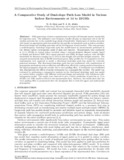| dc.contributor.author | Oyie, Nicholas O. | |
| dc.contributor.author | Afullo, T. J. O. | |
| dc.date.accessioned | 2021-04-20T09:20:52Z | |
| dc.date.available | 2021-04-20T09:20:52Z | |
| dc.date.issued | 2018-08 | |
| dc.identifier.citation | 2018 Progress In Electromagnetics Research Symposium (PIERS — Toyama), Japan, 1–4 August | en_US |
| dc.identifier.issn | 1559-9450 | |
| dc.identifier.uri | https://ieeexplore.ieee.org/document/8597901 | |
| dc.identifier.uri | http://hdl.handle.net/123456789/4593 | |
| dc.description.abstract | Fifth generation wireless communication networks will demand massive bandwidth for high data rates. The millimeter wave frequency bands will play an important role in the 5G wireless networks due to the available huge chunk of bandwidth. Deployment of wireless networks will require an appropriate path loss model for site-specific environments such as indoor corridors. Structural design and building materials call for development of such models. This work presents a multi-frequency dual-slope large-scale path loss model based on measurements performed in two distinct indoor environments made of glass and concrete. Measurements were conducted at 14 to 22 GHz in typical indoor corridors using a costume-designed channel sounder based on Rohde and Schwarz SMF 100A signal generator and FSIQ 40 signal analyzer with 120MHz bandwidth for distances ranging 2m to 24m in line-of-sight and non-line-of-sight scenarios. The acquired measurement data of 36,000 directional power delay profiles for 18 transmitter-receiver combinations were analyzed to model a directional dual-slope path loss model for vertically polarized antennas. The directional dual-slope path loss was synthesized with consideration of propagation mechanisms such as reflection and diffraction effectively causing modal attenuation as the signal propagates along the corridor due to wave guiding effect. A breakpoint was established that demonstrates the effects of modal attenuation in a waveguide like corridor. The model was evaluated by performing a comparative analysis on the directional dual-slope path loss model on various indoor corridors with different structural design and materials with well-known alfabeta- gamma model. The results were observed to give a better prediction of path loss at 14 to 22 GHz over ABG model as fitted to the measurement data. Moreover, the results show that the wave guiding effect is pronounced after the breakpoint due to both free space and multi-modal propagation. | en_US |
| dc.language.iso | en | en_US |
| dc.title | A Comparative Study of Dual-slope Path Loss Model in Various Indoor Environments at 14 to 22GHz | en_US |
| dc.type | Article | en_US |

